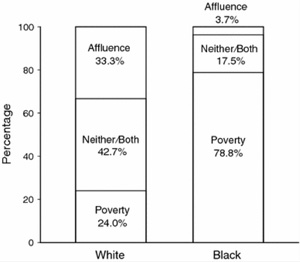“With President Obama now approaching six months in office, some have suggested that we have gone beyond race as a major dividing line in society. Yet nothing could be further from the truth,” says Mark R. Rank, Ph.D., professor of social work at Washington University in St. Louis. “One of the fundamental fault lines in American society continues to be the ongoing racial disparities in economic well-being.” Using 30 years of data, Rank examined three key factors in attaining economic well-being: owning a home and building equity; attaining affluence and avoiding poverty; and possessing enough assets to survive economic turmoil, or a “rainy day fund.”

“The results indicate that within each area, the economic racial divide across the American life course is immense,” Rank says.
“For whites, America represents a society in which both rags and riches are distinct possibilities, but the reality tends to bend somewhat more toward the side of riches. 55% of white Americans will reach affluence at some point during their adulthood, and nearly half of whites who are homeowners at age 25 will accrue at least $100,000 worth of home equity by the time they reach age 50.
“On the other hand, the American experience for blacks is synonymous with poverty—nearly 90% of all black Americans will encounter poverty in their lives, while only 13% will attain a level of affluence. Blacks are also approximately two times more likely than whites not to have enough savings to get them through tough times.”
Rank’s study is published in the current issue of the new journal, Race and Social Problems. He used data from the Panel Study of Income Dynamics (PSID). The PSID is the longest running longitudinal data set that contains in-depth information on family demographic and economic behavior. In this study, affluence is defined as 10 times the official poverty line. Today’s level of poverty for a family of four is approximately $22,000.
Rank says this research helps to explain why whites and blacks have such different perceptions of the American Dream and the possibilities of attaining it.
“We can clearly observe the cumulative disadvantage of being black in America. It is a disadvantage that begins in childhood and widens across the adulthood years,” he says. “Being black in America represents a significant, powerful and cumulative economic disadvantage across the course of a lifetime.”